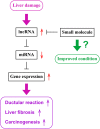Concise Review: Functional Roles and Therapeutic Potentials of Long Non-coding RNAs in Cholangiopathies
- PMID: 32154257
- PMCID: PMC7045865
- DOI: 10.3389/fmed.2020.00048
Concise Review: Functional Roles and Therapeutic Potentials of Long Non-coding RNAs in Cholangiopathies
Abstract
Long non-coding RNAs (lncRNAs) are RNAs with lengths exceeding 200 nucleotides that are not translated into proteins. It is well-known that small non-coding RNAs, such as microRNAs (miRNAs), regulate gene expression and play an important role in cholangiopathies. Recent studies have demonstrated that lncRNAs may also play a key role in the pathophysiology of cholangiopathies. Patients with cholangiopathies often develop cholangiocarcinoma (CCA), which is cholangiocyte-derived cancer, in the later stage. Cholangiocytes are a primary target of therapies for cholangiopathies and CCA development. Previous studies have demonstrated that expression levels of lncRNAs are altered in the liver of cholangiopathies or CCA tissues. Some lncRNAs regulate gene expression by inhibiting functions of miRNAs leading to diseased liver conditions or CCA progression, suggesting that lncRNAs could be a novel therapeutic target for those disorders. This review summarizes current understandings of functional roles of lncRNAs in cholangiopathies and seek their potentials for novel therapies.
Keywords: bile duct; cholangiocarcinoma; cholangiocytes; long non-coding RNAs; microRNAs.
Copyright © 2020 Sato, Glaser, Francis and Alpini.
Figures

Similar articles
-
MicroRNAs in Cholangiopathies.Curr Pathobiol Rep. 2014 Sep 1;2(3):133-142. doi: 10.1007/s40139-014-0048-9. Curr Pathobiol Rep. 2014. PMID: 25097819 Free PMC article.
-
Diagnostic and therapeutic potentials of microRNAs in cholangiopathies.Liver Res. 2017 Jun;1(1):34-41. doi: 10.1016/j.livres.2017.03.003. Epub 2017 Apr 26. Liver Res. 2017. PMID: 29085701 Free PMC article.
-
Cholangiopathies and the noncoding revolution.Curr Opin Gastroenterol. 2022 Mar 1;38(2):128-135. doi: 10.1097/MOG.0000000000000806. Curr Opin Gastroenterol. 2022. PMID: 35098934 Review.
-
The Cholangiopathies.Mayo Clin Proc. 2015 Jun;90(6):791-800. doi: 10.1016/j.mayocp.2015.03.017. Epub 2015 May 6. Mayo Clin Proc. 2015. PMID: 25957621 Free PMC article. Review.
-
Comprehensive analysis of long noncoding RNA-associated competing endogenous RNA network in cholangiocarcinoma.Biochem Biophys Res Commun. 2018 Dec 2;506(4):1004-1012. doi: 10.1016/j.bbrc.2018.10.186. Epub 2018 Nov 4. Biochem Biophys Res Commun. 2018. PMID: 30404735
Cited by
-
MiR-130a-3p Alleviates Liver Fibrosis by Suppressing HSCs Activation and Skewing Macrophage to Ly6Clo Phenotype.Front Immunol. 2021 Aug 5;12:696069. doi: 10.3389/fimmu.2021.696069. eCollection 2021. Front Immunol. 2021. PMID: 34421906 Free PMC article.
-
Long non-coding RNA ACTA2-AS1 promotes ductular reaction by interacting with the p300/ELK1 complex.J Hepatol. 2022 Apr;76(4):921-933. doi: 10.1016/j.jhep.2021.12.014. Epub 2021 Dec 23. J Hepatol. 2022. PMID: 34953958 Free PMC article.
-
Pathogenetic Role and Clinical Implications of Regulatory RNAs in Biliary Tract Cancer.Cancers (Basel). 2020 Dec 22;13(1):12. doi: 10.3390/cancers13010012. Cancers (Basel). 2020. PMID: 33375055 Free PMC article. Review.
-
Function of the Long Noncoding RNAs in Hepatocellular Carcinoma: Classification, Molecular Mechanisms, and Significant Therapeutic Potentials.Bioengineering (Basel). 2022 Aug 21;9(8):406. doi: 10.3390/bioengineering9080406. Bioengineering (Basel). 2022. PMID: 36004931 Free PMC article. Review.
-
Long Non-Coding RNAs in Biliary Tract Cancer-An Up-to-Date Review.J Clin Med. 2020 Apr 22;9(4):1200. doi: 10.3390/jcm9041200. J Clin Med. 2020. PMID: 32331331 Free PMC article. Review.
References
Publication types
Grants and funding
- R01 DK108959/DK/NIDDK NIH HHS/United States
- R21 AA025157/AA/NIAAA NIH HHS/United States
- R01 DK062975/DK/NIDDK NIH HHS/United States
- I01 BX002192/BX/BLRD VA/United States
- R01 DK107310/DK/NIDDK NIH HHS/United States
- I01 BX000574/BX/BLRD VA/United States
- R01 DK076898/DK/NIDDK NIH HHS/United States
- I01 BX003031/BX/BLRD VA/United States
- IK6 BX004601/BX/BLRD VA/United States
- R01 DK115184/DK/NIDDK NIH HHS/United States
- R01 DK119421/DK/NIDDK NIH HHS/United States
- IK6 BX005226/BX/BLRD VA/United States
- R21 AA025997/AA/NIAAA NIH HHS/United States
- R01 DK110035/DK/NIDDK NIH HHS/United States
- R01 DK054811/DK/NIDDK NIH HHS/United States
LinkOut - more resources
Full Text Sources

